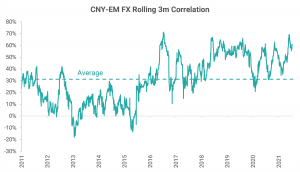Resumo do Relatório
FX Dashboard: Spillover Risk from China to EM FX
The 50 bp reserve requirement ratio (RRR) cut by the People’s Bank of China (PBOC) last week has thrown the market into confusion. There are two disparate narratives taking hold, leading to the uncertainty:
- The first narrative is that the RRR cut is not the beginning of an aggressive easing cycle. Rather, it is a preemptive step to ensure that the economic recovery does not lose ground in H2 and growth for the year as a whole stays within the current forecasts of 8-9%.
- The gloomier narrative is that that the authorities are seeing evidence of a greater-than-expected slowdown, especially given how quick the PBOC response was to the soft June data, particularly related to consumption and services. Moreover, among the instruments to add liquidity, an RRR cut is viewed as a powerful signal of easing, adding to the argument that the authorities must be concerned. A South China Morning Post article, for example, talks about the potential risk of recession and some of the pessimistic growth forecasts of economists dropping below 6% for H2.
Neither scenario is positive for the renminbi (CNY). Therefore, to capitalize on CNY potentially underperforming in the near term, we recommended yesterday to go Long Malaysian ringgit (MYR) against Short CNY.
Our baseline view is the first scenario as we see the easing as insurance and expect the economy to naturally slow from the heady growth of 18.3% in Q1 but remain robust. However, the second scenario can mean a greater need for currency weakness to support exports especially if the ongoing global recovery starts to moderate as well. The implications for the renminbi – and the broader EM FX complex – are therefore quite negative in this scenario.
As the chart below shows, the correlation of CNY with EM FX is close to the high end of the historical range. The correlation was low in the first half of the last decade, but even comparing with the history since 2016 shows that the current correlation level is very high.

Data Source: Refinitiv; Note: EM FX = equally weighted index of spot returns of 22 currencies
Moreover, as the chart below shows, the volatility of EM FX has moved hand in hand with CNY volatility since 2018. Therefore, all else equal, a spike in the volatility of CNY should coincide with higher EM FX volatility as well.

Data Source: Refinitiv; Note: EM FX = equally weighted index of spot returns of 22 currencies
Given the extent of outperformance of CNY since the pandemic (see the chart below), in theory, there is ample room for the currency to close the gap without a severe impact on EM FX. Nevertheless, if the renminbi’s devaluation is significant, then the reality is that EM FX on aggregate is likely to suffer as well, even if its beta to CNY is not high.
This makes sense from a fundamental perspective since China’s economy was the first to go into a lockdown and the first to bounce back from it. If the upcoming slowdown in China is sharp and more severe than currently expected, then it does not bode well for the ongoing recoveries in other emerging countries, given their trade and financial ties with China.
Although not our baseline view, it is important to watch if the more negative narrative starts to take hold because of its implication for EM assets and, more broadly, for global financial markets. The next relevant data in this regard is Q2 GDP to be released later this week. The focus will be on how much growth has slowed in Q2 relative to Q1.

Data Source: Refinitiv; Note: EM FX = equally weighted index of spot returns of 22 currencies
Best Longs / Best Shorts
- The lists of underperformers and outperformers based on our models in the attached FX Dashboard stayed unchanged.
- The list of underperformers consists of the Peruvian sol (PEN), the Philippine peso (PHP), and the Thai baht (THB) while the list of outperformers has the Brazilian real (BRL) and the Taiwan dollar (TWD) on it.
Best Crosses
- The list of preferred relative-value trades based on our models also remained unchanged with Short BRL vs Long PEN or Chilean peso (CLP) or Colombian peso (COP) or THB or PHP on it.
- The 3m expected returns for these pairs are high in the range of 14-19% (not annualized), assuming mean reversion.
Aviso legal
DISCLAIMER: Este Relatório de Análise foi elaborado e distribuído pelo Analista, signatário unicamente para uso do destinatário original, de acordo com todas as exigências previstas na Resolução CVM nº 20 de 26 de fevereiro de 2021 e tem como objetivo fornecer informações que possam auxiliar o investidor a tomar sua própria decisão de investimento, não constituindo qualquer tipo de oferta ou solicitação de compra e/ou venda de qualquer produto. As decisões de investimentos e estratégias financeiras devem ser realizadas pelo próprio leitor, os Analistas, ou a OHMRESEARCH não se responsabilizam por elas. Os produtos apresentados neste relatório podem não ser adequados para todos os tipos de investidores. Antes de qualquer decisão de investimentos, os investidores deverão realizar o processo de suitability no agente de distribuição de sua confiança e confirmar se os produtos apresentados são indicados para o seu perfil de investidor. A rentabilidade de produtos financeiros pode apresentar variações e seu preço ou valor pode aumentar ou diminuir num curto espaço de tempo. Os desempenhos anteriores não são necessariamente indicativos de resultados futuros. A rentabilidade divulgada não é líquida de impostos. As informações presentes neste material são baseadas em simulações e os resultados reais poderão ser significativamente diferentes.
O(s) signatário(s) deste relatório declara(m) que as recomendações refletem única e exclusivamente suas análises e opiniões pessoais, que foram produzidas de forma totalmente independente e que a OHMRESEARCH não tem qualquer gerência sobre este conteúdo. As opiniões aqui expressas estão sujeitas a modificações sem aviso prévio em decorrência de alterações nas condições de mercado. O Analista responsável pelo conteúdo deste relatório e pelo cumprimento da Resolução CVM nº 20/21 está indicado acima, sendo que, caso constem a indicação de mais um analista no relatório, o responsável será o primeiro analista credenciado a ser mencionado no relatório. Os analistas cadastrados na OHMRESEARCH estão obrigados ao cumprimento de todas as regras previstas no Código de Conduta da APIMEC para o Analista de Valores Mobiliários e no Manual de Controles Internos para Elaboração e Publicação de Relatórios da OHMRESEARCH. De acordo com o art. 21 da Resolução CVM nº 20/21 caso o Analista esteja em situação que possa afetar a imparcialidade do relatório ou que configure ou possa configurar conflito de interesse, este fato deverá estar explicitado no campo “Conflitos de Interesse” deste relatório.
O conteúdo deste relatório é de propriedade única do Analista signatário e não pode ser copiado, reproduzido ou distribuído, no todo ou em parte, a terceiros, sem prévia e expressa autorização deste Analista. Todas as informações utilizadas neste documento foram redigidas com base em informações públicas, de fontes consideradas fidedignas. Embora tenham sido tomadas todas as medidas razoáveis para assegurar que as informações aqui contidas não são incertas ou equívocas no momento de sua publicação, o Analista não responde pela veracidade das informações do conteúdo.
Para maiores informações, pode-se ler a Resolução CVM nº 20/21 e o Código de Conduta da APIMEC para o Analista de Valores Mobiliários. Este relatório é destinado exclusivamente ao assinante da OHMRESEARCH que o contratou. A sua reprodução ou distribuição não autorizada, sob qualquer forma, no todo ou em parte, implicará em sanções cíveis e criminais cabíveis, incluindo a obrigação de reparação de todas as perdas e danos causados, nos termos da Lei nº 9.610/98 e de outras aplicáveis.





